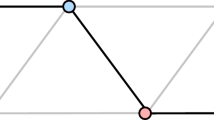Abstract
We discretize the Weyl equation for a massless, spin-1/2 particle on a time-diagonal, hypercubic spacetime lattice with null faces. The amplitude for a step of right-handed chirality is proportional to the spin projection operator in the step direction, while for left-handed it is the orthogonal projector. Iteration yields a path integral for the retarded propagator, with matrix path amplitude proportional to the product of projection operators. This assigns the amplitude i ±T 3−B/2 2−N to a path with N steps, B bends, and T right-handed minus left-handed bends, where the sign corresponds to the chirality. Fermion doubling does not occur in this discrete scheme. A Dirac mass m introduces the amplitude i 𝜖 m to flip chirality in any given time step 𝜖, and a Majorana mass similarly introduces a charge conjugation amplitude.



Similar content being viewed by others
Notes
See [14] for a general investigation of spacetime polytopes with null faces.
The eigenvalues of A(𝜃) have modulus less than or equal to unity if and only if the step speed α is ≥3. Our choice α=3 is thus the marginal value for a convergent finite difference scheme.
References
Finkelstein, D.: Space-time code. Phys. Rev. 184, 1261 (1969)
Finkelstein, D. R.: Quantum Relativity: A Synthesis of the Ideas of Einstein and Heisenberg. Springer, Berlin (1996)
Feynman, R. P.: An Operator calculus having applications in quantum electrodynamics. Phys. Rev. 84, 108 (1951)
Finkelstein, D.: First flash and second vacuum. Int. J. Theor. Phys. 28, 1081 (1989)
Finkelstein, D.R., Saller, H., Tang, Z.: Beneath gauge. Class. Quant. Grav. 14, A127 (1997). arXiv:quant-ph/9608023
Feynman, R.P.: The development of the space-time view of quantum electrodynamics. Science 153 (3737), 699 (1966). [Phys.Today 19N8, no. 8, 31 (1966)] [World Sci.Ser.20th Cent.Phys.27, 9 (2000)] [http://www.nobelprize.org/nobel_prizes/physics/laureates/1965/feynman-lecture.html Version at nobelprize.org]
Feynman, R. P., Hibbs, A. R.: Quantum mechanics and path integrals, Problem 2-6, McGraw-Hill Inc. (1965)
Münster, G.: Lattice quantum field theory. Scholarpedia 5(12), 8613 (2010). doi:10.4249/scholarpedia.8613 10.4249/scholarpedia.8613
Weisz, P., Majumdar, P.: Lattice gauge theories. Scholarpedia 7(4), 8615 (2012). doi:10.4249/scholarpedia.8615 10.4249/scholarpedia.8615
Riazanov, G.V.: The Feynman path integral for the Dirac equation. Zh. Eksp. Teor. Fiz. 33, 1437 (1957). [Sov. Phys. JETP 6, 1107 (1958)]
Jacobson, T. A.: Ph.d. dissertation. University of Texas-Austin (1983)
Bialynicki-Birula, I.: Dirac and Weyl equations on a lattice as quantum cellular automata. Phys. Rev. D 49, 6920 (1994). arXiv:hep-th/9304070
Schaden, M.: Causal space-times on a null lattice. arXiv:1509.03095[gr-qc]
Neiman, Y.: Causal cells: spacetime polytopes with null hyperfaces. Geom Dedicata 168, 161 (2014). arXiv:1212.2916[math.CO]
Jacobson, T.: Spinor chain path integral for the Dirac equation. J. Phys. A 17, 2433 (1984)
Jacobson, T.: Feynman’s checkerboard and other games. Lect. Notes Phys. 226, 386 (1985). doi:10.1007/3-540-15213-X_88
Acknowledgments
We are grateful to E. Hawkins for mathematical aid, and to Yigal Shamir and Paulo Bedaque for instruction about lattice fermions. This work was supported in part by the NSF under grants PHY-9800967, PHY-0300710, PHY-0601800, PHY-0903572, PHY-1407744 at the University of Maryland, in part by the CNRS at the Insitut d’Astrophysique de Paris, and by Perimeter Institute for Theoretical Physics. Research at Perimeter Institute is supported by the Government of Canada through Industry Canada and by the Province of Ontario through the Ministry of Research & Innovation.
Author information
Authors and Affiliations
Corresponding author
Appendix A: Norm of the Amplification Matrix
Appendix A: Norm of the Amplification Matrix
In this appendix we prove that the norm of the matrix A(𝜃) defined in (28) is less than unity unless at least three of the 𝜃 i coincide, in which case the norm is unity. The proof is due to Eli Hawkins.
Let |ν〉 be any unit spinor. The squared norm of A|ν〉 is ∥A|ν〉∥2=〈ν|A ‡ A|ν〉, whose maximum is the larger eigenvalue of A ‡ A. This value defines the squared norm ∥A∥2.
Using the definition of the spin projection operators (8) and the inner products of the unit vectors \(\hat {n}_{i}\) (1 if i = j and \(-\frac 13\) if i≠j) we find
where the sum is over the 6 choices of {i,j}⊂{1,2,3,4}. This trace is at most 2, and therefore the smaller eigenvalue of A ‡ A is less than 1 unless A ‡ A=1. Hence
has the same sign as 1−∥A∥.
The matrix A ‡ A is linear in terms of \(e^{i(\theta _{i}-\theta _{j})}\), therefore Φ is quadratic. Because Φ is invariant under all permutations of the 𝜃’s, it can be written as a quadratic function of the cosines cos(𝜃 i −𝜃 j ). Because Φ vanishes when the 𝜃’s are all equal, it is convenient to write it in terms of the cosines minus 1. It thus takes the form,
The last sum is over the 3 partitions of {1,2,3,4} into pairs. When 𝜃 2 = 𝜃 3 = 𝜃 4, A takes the form (16), which obviously has an eigenvalue of unit modulus. Therefore Φ=0 in this case, which shows that a = b=0. To determine the value of c, consider the case that 𝜃 1 = 𝜃 2=0 and 𝜃 3 = 𝜃 4 = π. Then \(A=\frac 12(\hat {n}_{1}+\hat {n}_{2})\cdot \vec {\sigma }\), so A ‡ A=1/3, hence Φ=4/9. The last sum in (46) is 8, so c=1/18.
The determinant Φ is thus given by
This satisfies Φ≥0, therefore ∥A∥≤1. Each term is non-negative, therefore Φ=0 only if every term vanishes. This occurs only if at least three of the 𝜃’s are equal.
Rights and permissions
About this article
Cite this article
Foster, B.Z., Jacobson, T. Spin on a 4D Feynman Checkerboard. Int J Theor Phys 56, 129–144 (2017). https://doi.org/10.1007/s10773-016-3170-0
Received:
Accepted:
Published:
Issue Date:
DOI: https://doi.org/10.1007/s10773-016-3170-0



